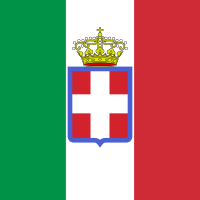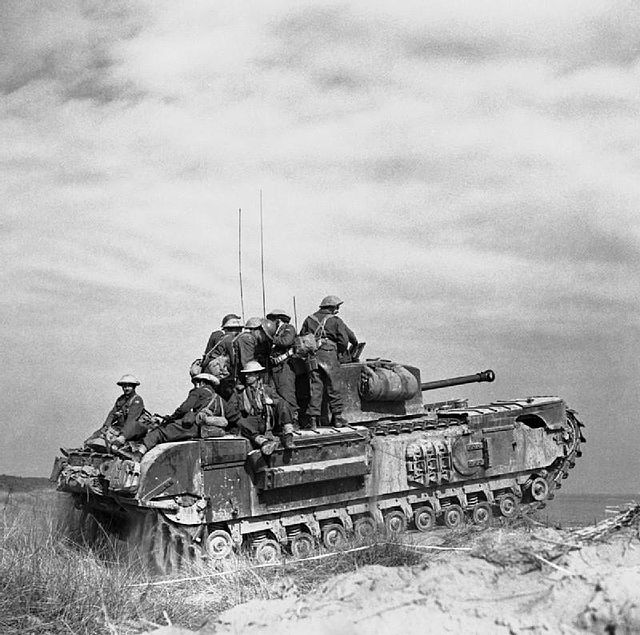Loading AI tools
Pro-allied Italian armed forces From Wikipedia, the free encyclopedia
The Italian Co-belligerent Army (Italian: Esercito Cobelligerante Italiano), or Army of the South (Esercito del Sud), were names applied to various division sets[clarify] of the now former Royal Italian Army during the period when it fought alongside the Allies during World War II from October 1943 onwards. During the same period, the pro-allied Italian Royal Navy and Italian Royal Air Force were known as the Italian Co-belligerent Navy and Italian Co-belligerent Air Force respectively. From September 1943, pro-Axis Italian forces became the National Republican Army of the newly formed Italian Social Republic.
| Italian Co-belligerent Army Esercito Cobelligerante Italiano | |
|---|---|
 Flag of Italy with the emblem of Savoia | |
| Active | 1943–1945 |
| Country | |
| Allegiance | King of Italy and Prime Minister |
| Type | Army |
| Role | Co-belligerent allied-resistance forces of the Kingdom of Italy's government in exile |
| Size | 266,000 to 326,000 |
| Part of | |
| Garrison/HQ | Brindisi |
| Nickname(s) | Army of the South |
| Patron | King |
| Engagements | World War II (Italian Civil War) |
| Commanders | |
| Ceremonial chief | Victor Emmanuel III |
| Notable commanders | |
The Italian Co-belligerent Army was the result of the Allied armistice with Italy on 8 September 1943; King Victor Emmanuel III dismissed Benito Mussolini as Prime Minister in July 1943 following the Allied invasion of Southern Italy, and nominated Marshal of Italy (Maresciallo d'Italia) Pietro Badoglio instead, who later aligned Italy with the Allies to fight the Social Republic's forces and its German allies in Northern Italy.
The Italian Co-belligerent Army fielded between 266,000 and 326,000 troops in the Italian Campaign, of whom 20,000 (later augmented to 50,000, though some sources place this number as high as 99,000) were combat troops and between 150,000 and 190,000 were auxiliary and support troops, along with 66,000 personnel involved with traffic control and infrastructure defence.[1] On the whole, the Italian Co-Belligerent Army made up 1/8 of the fighting force and 1/4 of the entire force of 15th Army Group of the Allied Forces.
The first formation of the Co-belligerent Army was the I Motorized Grouping (Italian: I Raggruppamento Motorizzato) created on 27 November 1943 in San Pietro Vernotico near Brindisi. The units for the I Motorized Grouping were drawn from the 58th Infantry Division "Legnano" and 18th Infantry Division "Messina".[2] Some of the soldiers who joined the unit had managed to evade capture and internment by German forces.[3] The unit was composed of 295 officers and 5,387 men and was created to participate alongside the Allies against Germany and the Italian Social Republic in the Italian campaign. The unit was commanded by General Vincenzo Dapino, who led it during its first engagement in the Battle of San Pietro Infine in December of the same year. This action did much to remove the Allies' distrust of Italian soldiers fighting on their side.[4] The unit suffered heavy casualties and was judged to have performed satisfactorily.[5]
Following the service with the American Fifth Army and reorganization, command of the I Motorized Grouping was given to General Umberto Utili and the unit was transferred to the Polish II Corps on the extreme left of the British Eighth Army.[4] In early 1944 the unit was reorganised and expanded into the Italian Liberation Corps.[6]
On 18 April 1944, the I Motorized Grouping (now 16,000 men strong) assumed the name Italian Liberation Corps (Italian: Corpo Italiano di Liberazione, or CIL) and was divided into two brigades.[7][4] The CIL was augmented with the 6,000 men strong 184th Paratroopers Division "Nembo". The CIL's commander was General Umberto Utili. In early 1944, a 5,000-man force of Italians fought on the Gustav Line around Monte Cassino and acquitted itself well. The Italians once again suffered heavy casualties.[5]
After the Battle of Filottrano in July 1944 the Italian government proposed to increase the number of Italian troops fighting on the Allied side. The proposal was accepted and in September 1944 the CIL was taken out of the line and sent to the rear to be equipped with British material, including British Battledress uniforms and helmets. On 24 September 1944, the CIL was disbanded and its personnel and units used to form the first combat groups: "Legnano" and "Folgore". Soon four more combat groups were formed: "Cremona", "Friuli", "Mantova", and "Piceno". These groups were equal in size to weak divisions. The established strength for each was 432 officers, 8,578 other ranks, 116 field guns, 170 mortars, 502 light machine guns, and 1,277 motor vehicles. The Combat Groups were given the names of old Royal Army divisions and followed the numbering system of older regiments to some extent.[5] These groups were attached to various American and British formations on the Gothic Line. The following is the "order of battle" of the Italian Co-belligerent Army as of April 1945.[8]
The Chief of Staff of the Armed Forces High Command was Marshal Giovanni Messe, while the Chief of Staff of the Army was Lieutenant General Paolo Berardi.
Each infantry regiment fielded three infantry battalions, a mortar company armed with British ML 3 inch mortars and an anti-tank company armed with British QF 6 pounder guns. The artillery regiments consisted of four artillery groups with British QF 25 pounder guns, one anti-tank group with British QF 17 pounder guns and one anti-air group armed with British versions of the Bofors 40mm gun.

In addition to the Combat Groups the Italian Co-belligerent Army included eight Auxiliary Divisions (Italian: Divisioni Ausiliarie) for labour, support and second-line duties. At its peak the division fielded about 150,000-190,000. These auxiliary units were the following:
On the whole the Italian Co-Belligerent Army made up 1/8 of the fighting force and 1/4 of the entire force of 15th Army Group of the Allied Forces.[9]
Not directly dependent from the Allied Headquarters in Italy the Co-Belligerent Army also deployed three Internal Security Divisions (Divisioni di Sicurezza Interna) for internal security duties:
In 1946, the Kingdom of Italy became the Italian Republic. In a similar manner, what had been the royalist Co-Belligerent Army simply became the Italian Army (Esercito Italiano).
The Italian Liberation Corps suffered 1,868 killed and 5,187 wounded during the Italian campaign;[10] the Italian Auxiliary Divisions lost 744 men killed, 2,202 wounded and 109 missing.[11] Some sources estimate the overall number of members of the Italian regular forces killed on the Allied side as 5,927.[12]
Seamless Wikipedia browsing. On steroids.
Every time you click a link to Wikipedia, Wiktionary or Wikiquote in your browser's search results, it will show the modern Wikiwand interface.
Wikiwand extension is a five stars, simple, with minimum permission required to keep your browsing private, safe and transparent.